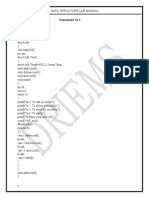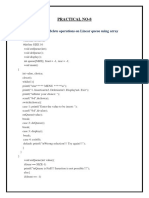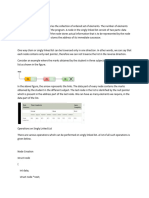0 ratings0% found this document useful (0 votes)
4 viewsSingly Linked list in c programming language
The document provides a comprehensive overview of linked lists in C, including implementation details for singly linked lists, operations such as insertion, deletion, and searching, as well as advantages and disadvantages. It also compares linear and non-linear data structures, discusses different types of linked lists, and presents a program for reversing a linked list. Additionally, it compares linked lists with linear arrays, outlining when to use each data structure based on specific requirements.
Uploaded by
kodurisaikiran1437Copyright
© © All Rights Reserved
Available Formats
Download as DOCX, PDF, TXT or read online on Scribd
0 ratings0% found this document useful (0 votes)
4 viewsSingly Linked list in c programming language
The document provides a comprehensive overview of linked lists in C, including implementation details for singly linked lists, operations such as insertion, deletion, and searching, as well as advantages and disadvantages. It also compares linear and non-linear data structures, discusses different types of linked lists, and presents a program for reversing a linked list. Additionally, it compares linked lists with linear arrays, outlining when to use each data structure based on specific requirements.
Uploaded by
kodurisaikiran1437Copyright
© © All Rights Reserved
Available Formats
Download as DOCX, PDF, TXT or read online on Scribd
You are on page 1/ 5
1.
C Program to Implement Singly Linked List:
#include <stdio.h>
#include <stdlib.h>
struct Node {
int data;
struct Node* next;
};
struct Node* head = NULL;
// Function to create a new node
struct Node* createNode(int data) {
struct Node* newNode = (struct Node*)malloc(sizeof(struct Node));
if (newNode == NULL) {
printf("Memory allocation failed!\n");
exit(1);
}
newNode->data = data;
newNode->next = NULL;
return newNode;
}
// Function to insert at the beginning
void insertAtBeginning(int data) {
struct Node* newNode = createNode(data);
newNode->next = head;
head = newNode;
}
// Function to insert at the end
void insertAtEnd(int data) {
struct Node* newNode = createNode(data);
if (head == NULL) {
head = newNode;
} else {
struct Node* temp = head;
while (temp->next != NULL) {
temp = temp->next;
}
temp->next = newNode;
}
}
// Function to insert at a given position
void insertAtPosition(int data, int position) {
if (position == 0) {
insertAtBeginning(data);
} else {
struct Node* newNode = createNode(data);
struct Node* temp = head;
for (int i = 0; i < position - 1 && temp != NULL; i++) {
temp = temp->next;
}
if (temp == NULL) {
printf("Invalid position!\n");
} else {
newNode->next = temp->next;
temp->next = newNode;
}
}
}
// Function to delete from the beginning
void deleteFromBeginning() {
if (head == NULL) {
printf("List is empty!\n");
} else {
struct Node* temp = head;
head = head->next;
free(temp);
}
}
// Function to delete from the end
void deleteFromEnd() {
if (head == NULL) {
printf("List is empty!\n");
} else if (head->next == NULL) {
free(head);
head = NULL;
} else {
struct Node* temp = head;
while (temp->next->next != NULL) {
temp = temp->next;
}
free(temp->next);
temp->next = NULL;
}
}
// Function to delete from a given position
void deleteFromPosition(int position) {
if (head == NULL) {
printf("List is empty!\n");
} else if (position == 0) {
deleteFromBeginning();
} else {
struct Node* temp = head;
for (int i = 0; i < position - 1 && temp != NULL; i++) {
temp = temp->next;
}
if (temp == NULL || temp->next == NULL) {
printf("Invalid position!\n");
} else {
struct Node* toDelete = temp->next;
temp->next = toDelete->next;
free(toDelete);
}
}
}
// Function to search for an element
int search(int data) {
struct Node* temp = head;
int position = 0;
while (temp != NULL) {
if (temp->data == data) {
return position;
}
temp = temp->next;
position++;
}
return -1; // Element not found
}
// Function to display the linked list
void display() {
struct Node* temp = head;
printf("List: ");
while (temp != NULL) {
printf("%d ", temp->data);
temp = temp->next;
}
printf("\n");
}
int main() {
// Example usage:
insertAtEnd(10);
insertAtBeginning(20);
insertAtPosition(30, 1);
insertAtEnd(40);
display();
deleteFromBeginning();
deleteFromEnd();
deleteFromPosition(1);
display();
printf("Position of 30: %d\n", search(30));
return 0;
}
2. Difference Between Linear and Non-linear Data Structures:
● Linear:
○ Elements are arranged in a sequence.
○ Access to elements is sequential (e.g., arrays, linked lists, stacks, queues).
● Non-linear:
○ Elements are not arranged in a sequence.
○ Access to elements is not sequential (e.g., trees, graphs).
● Static:
○ Fixed size at compile time.
○ Memory allocation is done during compilation.
○ Examples: Arrays.
● Non-static:
○ Size can change dynamically during runtime.
○ Memory allocation is done during runtime.
○ Examples: Linked lists.
3. Advantages, Applications, and Disadvantages of Linked Lists:
● Advantages:
○ Dynamic size: Can grow or shrink as needed.
○ Efficient insertions and deletions (especially at the beginning).
○ Can be used to implement other data structures like stacks, queues, and
graphs.
● Applications:
○ Implementing dynamic memory allocation.
○ Representing data with variable-length records.
○ Implementing symbol tables in compilers.
○ Implementing file systems.
● Disadvantages:
○ Random access is not efficient.
○ Extra memory is required for pointers.
4. Different Types of Linked Lists:
● Singly Linked List: Each node points to the next node.
● Doubly Linked List: Each node points to both the next and previous nodes.
● Circular Linked List: The last node points back to the first node.
● Circular Doubly Linked List: A combination of circular and doubly linked lists.
5. C Program to Reverse a Linked List:
#include <stdio.h>
#include <stdlib.h>
struct Node {
int data;
struct Node* next;
};
struct Node* head = NULL;
// Function to reverse the linked list
void reverseList() {
struct Node* prev = NULL;
struct Node* current = head;
struct Node* next;
while (current != NULL) {
next = current->next;
current->next = prev;
prev = current;
current = next;
}
head = prev;
}
// ... (other functions from the previous code) ...
int main() {
// ... (same as in the previous code) ...
reverseList();
display();
return 0;
}
6. Comparison Between Linked List and Linear Array:
Feature Linked List Array
Memory Allocation Dynamic Static
Insertion/Deletion Efficient at beginning/end, Inefficient at beginning/end,
less efficient in the middle efficient in the middle
Random Access Inefficient Efficient
Memory Usage More memory overhead due Less memory overhead
to pointers
● When to use Linked List:
○ When frequent insertions and deletions are required.
○ When the size of the data structure is not known in advance.
○ When random access is not critical.
● When to use Array:
○ When random access is frequent.
○ When memory usage is a concern.
○ When the size of the data structure is known in advance.
You might also like
- 2023kuec2068 - Assigment 3 (Practise q.2)No ratings yet2023kuec2068 - Assigment 3 (Practise q.2)130 pages
- Algorithm for Deletion in a Doubly Linked ListNo ratings yetAlgorithm for Deletion in a Doubly Linked List6 pages
- Dsa Assignment-Ii: Name: Snehasish BanikNo ratings yetDsa Assignment-Ii: Name: Snehasish Banik18 pages
- Aku-Eb Model Paper 2020 For Teaching & LearningNo ratings yetAku-Eb Model Paper 2020 For Teaching & Learning8 pages
- Data Structures: Dr. Seemab Latif Arrays and PointersNo ratings yetData Structures: Dr. Seemab Latif Arrays and Pointers26 pages
- International Journal of Database Management Systems (IJDBMS)No ratings yetInternational Journal of Database Management Systems (IJDBMS)2 pages
- Assignment (Procedure Text) 14-111-3244 Shandro Eka Wijaya TIB - SORENo ratings yetAssignment (Procedure Text) 14-111-3244 Shandro Eka Wijaya TIB - SORE5 pages
- Output Determination: Contributed by Prabhakant Tiwari Under The Guidance of SAP GURU INDIA100% (1)Output Determination: Contributed by Prabhakant Tiwari Under The Guidance of SAP GURU INDIA9 pages
- Digital Circuits & Fundamentals of Microprocessor: B.E. (Computer Science & Engineering (New) ) Third Semester (C.B.S.)No ratings yetDigital Circuits & Fundamentals of Microprocessor: B.E. (Computer Science & Engineering (New) ) Third Semester (C.B.S.)2 pages
- Advanced C Concepts and Programming: First EditionFrom EverandAdvanced C Concepts and Programming: First Edition
- Data Structures: Dr. Seemab Latif Arrays and PointersData Structures: Dr. Seemab Latif Arrays and Pointers
- International Journal of Database Management Systems (IJDBMS)International Journal of Database Management Systems (IJDBMS)
- Assignment (Procedure Text) 14-111-3244 Shandro Eka Wijaya TIB - SOREAssignment (Procedure Text) 14-111-3244 Shandro Eka Wijaya TIB - SORE
- Output Determination: Contributed by Prabhakant Tiwari Under The Guidance of SAP GURU INDIAOutput Determination: Contributed by Prabhakant Tiwari Under The Guidance of SAP GURU INDIA
- Digital Circuits & Fundamentals of Microprocessor: B.E. (Computer Science & Engineering (New) ) Third Semester (C.B.S.)Digital Circuits & Fundamentals of Microprocessor: B.E. (Computer Science & Engineering (New) ) Third Semester (C.B.S.)

























































































